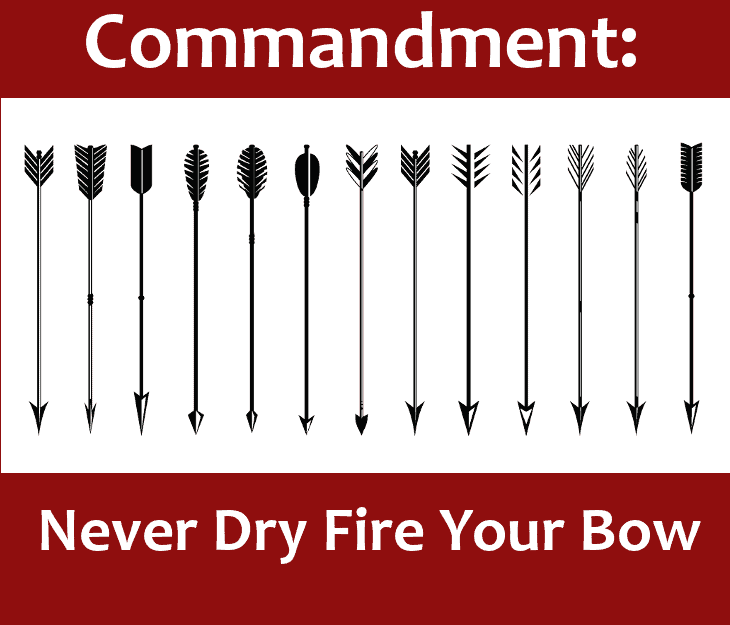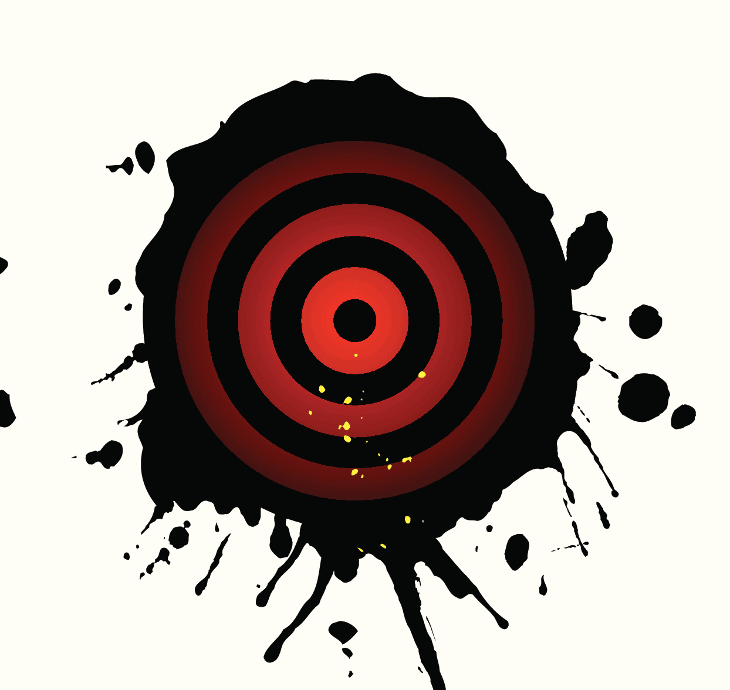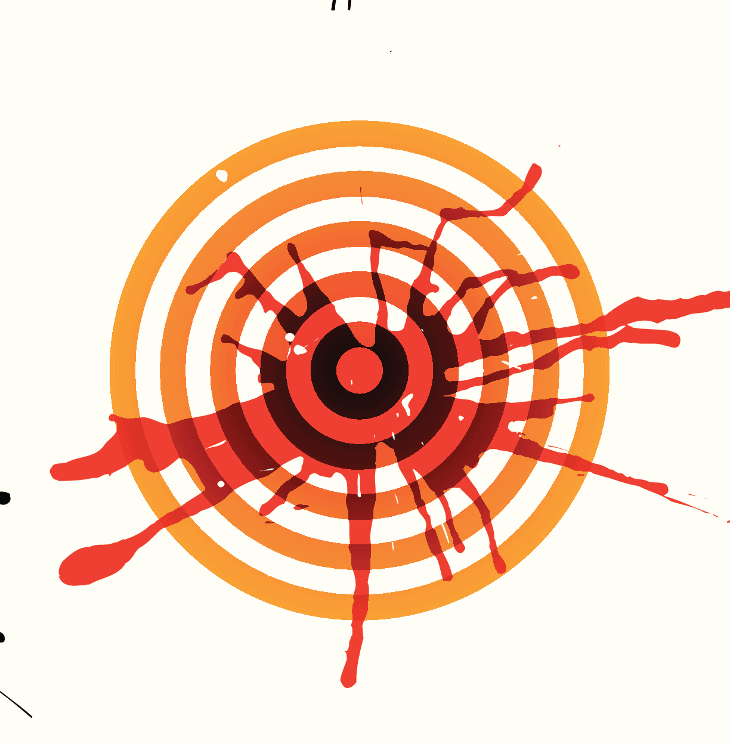If you’ve ever been to the range, you’ve probably heard this multiple times, from multiple people:
“Never, ever dry fire your bow.”
It may seem like a bit much, and the people reminding you about it may seem like worry-warts, but dry fires are actually really dangerous, and there’s a reason why people get so panicky about them.
This is an important one, so let’s get into it. We’ll start with the basics, and then get into some details:

Dry Firing a Bow: What It Is, Why It’s Bad
Basically, the term “dry fire” refers to when a person pulls back the bow string, and releases the bow string without an arrow.
In-and-of-itself, that doesn’t seem like such a bad thing, right? Archers new to the sport don’t always see that it’s a big deal. What’s the difference whether the bow has an arrow in it or not?
Here’s what happens during a regular shot cycle:
When a bow is drawn with an arrow—that is, when you nock an arrow and pull the bow string back towards your face—the limbs of the bow store the energy of your draw. You can see them bend backwards as you pull back the bow string, and they desperately want to return to their original position. When you release the bow string, the limbs pull the bow string forward, and the bow string pushes the arrow forward. The energy stored in the limbs when you release the bow string is transferred to string and to the arrow, and all that energy launches the arrow at your target. Some of that energy goes back into the bow—and if you’ve ever shot an arrow and felt the bow shake, that’s why—but the great majority of that energy goes into the arrow.
That’s how the shot process is supposed to go. But here’s what happens when you dry fire a bow, and why it’s such a big deal:
When a bow is drawn WITHOUT an arrow and the string is released, the energy that’s stored in the limbs has nowhere to go, and the energy vibrates powerfully throughout all parts of the bow—through the limbs, through the riser, and if you’re using a compound bow, through the cams. Those vibrations are so powerful, in fact, that it can actually destroy the bow—and sends parts of the bow flying in every direction.
A dry fire can result in cracking or splintering of the limbs, string breakage, and cams/other parts fracturing, but that’s not the worst news: all those parts cracking and flying through the air can cause you severe physical damage, resulting in blindness/loss of vision (if one of those parts flies into your eye—and when you think about it, we hold our bows pretty darn close to our eyes), lacerations/cuts (some of the pieces/gear that can fly off a bow can cut you, and that’s especially true if you’re got an extremely sharp broadhead at the end of your arrow), and some pretty severe bruising (if you get hit by an errant bow string).
Here’s a video of a dry fire, resulting in severe bow damage:
If you look, the guy in the video actually had an arrow, but he didn’t nock it correctly—that is, he didn’t attach the end of the arrow to the draw string—so it was basically as though he were firing with no arrow at all. That’s actually a really common cause of dry fires, and it can also happen when the nock—the part of the arrow you attach to your bow string—is weak or disintegrates during your draw (so always check to see that your arrows look OK!).
Why this guy is drawing in his front yard is a mystery, and that’s his first mistake. His second mistake is obviously the dry fire, and look how that bow comes apart—you can literally see pieces flying everywhere. The only thing that seems to stay in place is the bow sight.
Here’s another guy dry firing a bow (and to all you folks who publish videos of dry fires, we thank you for your courage! You’re doing a good thing, by helping us get the word out about dry fires!)
In the first video we posted, you see the bow come apart in slow motion. You can see see the limbs fly forward and crack off the bow, the arrow dangle on the shelf, and the string strike outward. This video isn’t in slow-motion, though, and that makes it a lot more life-like. After releasing the bow string, the archer is standing there, surprised, trying to figure out what just happened. That’s very common—a dry fire can happen so quickly, you’re not sure at first what’s going on.
Here’s one last video, and it may be the most important one of all—it’s a clip of veteran archer Tim Gillingham dry-firing a bow.
In you’re not familiar with him, Mr. Gillingham is a professional archer—his literally shoots arrows for a living—and he’s been sending arrows for more than 30 years. Here’s his write-up on Team Bowtech, and here’s his profile on World Archery that reviews his career win/loss record. He is, in every sense of the word, “the real deal.”
Here’s Mr. Gillingham dry firing a bow at the Archery Trade Association conference:
The other guy even says to him, “Don’t dry fire this bow”—Mr. Gillingham dry fires it!
So why did we post this last one video?
Because we want to remind you that dry-firing doesn’t only happens to beginners. Anyone—even an absolute pro like Tim Gillingham—can end up dry firing a bow.
But Wait! In That Last Video, Wasn’t the Bow Fine?
You may be saying to yourself, “Well, that bow didn’t fly apart, like the bows in the other videos,” and you’re right. Good eye!
Sometimes a bow that goes through a dry fire doesn’t fall apart, and there are even some Hoyt bows that are specifically designed to endure dry firing mistakes. Those are rare, though, and you should always assume that your bow will experience severe damage during a dry fire.
But just because your bow doesn’t fall to pieces after a dry fire doesn’t mean it’s OK. It may have damage to the limbs/cam/riser/bow string that’ll make the bow dangerous to use in the future. It may even look perfectly fine, but there may be internal damage that you can’t see, that may cause the bow to snap/crackle/pop somewhere down the line. You can be going about your business, shooting away, when all of us a sudden your bow falls to pieces in every direction.
So, with that in mind, it’s time to discuss…
What To Do If You Dry Fire Your Bow
We’ll start with the obvious one: if you’re bow is destroyed, that’s the end of that. Do not try to put your bow back together again, or replace broken parts with equipment from other bows. If your bow has obvious structural damage from a dry fire, you’ll need to retire that bow.
If your bow somehow stays together, you’ll need to take it to a pro shop and have them inspect it. Try to give them as much detail as possible about the event (what happened, what went wrong, and what pieces went where), along with as much information about the bow as you can remember (what make and model it is, how old it is, if it’s been refurbished, etc.). They’ll be able to tell you if the bow is safe to use, and if it’s not, what you can do.
Alright! Now you know the basics—what is a dry fire, and the damage it can do to a bow (and to you). Now let’s take a look at…
Some Safety Tips Related to Dry Fires
Dry fires tend to happen under certain circumstances, so here are some things to keep in mind:
People Who Are Have Never Held a Bow Are VERY Likely to Dry Fire
This is a very frequent scenario: you and your significant other have friends over for dinner (or whatever). You just got a new bow, and it’s beautiful. Your friend says, “I heard you just got a new bow! I’d love to see it.” So you go out to the garage / shed / wherever, and your friend grabs the bow. Before you can say, “WAIT WAIT WAIT don’t pull the string back,” your friend has drawn and dry-fired the bow, blinding himself, and ruining your beautiful new bow.
OK, so that’s a worst-case scenario, but the first part of it—a newbie handling someone else’s bow—is a very common way that dry fires occur. If you’re showing off a new bow, do NOT let newbies handle it, and if you are going to hand it over, make sure you say beforehand, “Listen, there’s this thing called a dry fire, and it’s when…” etc etc etc.
Arrows That Are Too Light Can Result in Dry-Fire-Like Results
Here’s an interesting fact that many archers overlook: if you’re using arrows that are too light, that can mean that too much of the energy in the limbs is being transferred back to your bow instead of into the arrow. That can result in all of the problems we mentioned above, so be sure to check the weight of your arrows. We’ve written a few posts on how to choose arrows, but you should always check with the manufacturer’s measurement tables, and follow up by asking the folks at your range or pro shop.
Dry Firing a Recurve is Bad; Dry Firing a Compound Bow is Worse
Because compound bows are so powerful—the force of the draw is magnified by the lever system—the damage to a compound bow after a dry fire will be much, much worse than the damage to a recurve bow. Plus, because there are so many more parts to a compound bow—literally, there are more moving parts—those parts are more likely to break and scatter into the air. Broken parts that are scattered in the air are more likely to end up in your eye and blind you.
So if you’re a recurve archer, be careful. If you’re a compound archer… be careful-er.
Seriously, It Really Can Happen to Anyone
“Cool! No problem,” you may be saying. “Don’t dry fire a bow. Got it.”
After all, most people are pretty smart and they want to be safe: you tell them something is dangerous, and they’ll refrain from doing it. But here’s the rub:
Most dry fires aren’t committed because the person is being a hot dog, or forgetful, or anything like that: most dry fires are made by mistake. The string slips. You sneeze. Or, as in the video we saw above, the arrow isn’t correctly nocked when the bow string is drawn.
So, how do you minimize mistakes? As the Good Book says, “Be sober; be vigilant.” Always be alert. Archery is very much about mindfulness—total awareness of your body and your bow and your target—and that applies to your actions on the line, and off it.
One Last Thing We Should Mention: Social Stigma
Here’s the most amazing thing about dry firing a bow: aside from the damage to equipment and the possible bodily harm the archer could experience, there is a social stigma to dry firing a bow that is also quite unpleasant. You’ll be “that guy.”
If you dry fire a bow at a range, chances are very strong you will have many people, all at once, saying to you “WOAH WOAH WOAH! What are you doing? Don’t you know that dry firing a bow can cause…” etc etc etc.
As a matter of fact, if you feel ignored at the range and you’re not getting enough attention, dry fire a bow—you’ll have a lot of eyes on you, right quick.
(We’re kidding. Never dry fire you bow.)
In other words, on top of all the danger of dry firing a bow, you’ll look like a dummy.
Alright! Moving On…
The “Never Dry Fire” commandment is an important one, and hopefully the videos above give you a good idea of what can happen. So don’t dry fire your bow.
We’ll move on to the next commandment, which is… Don’t Be a Tough Guy.



